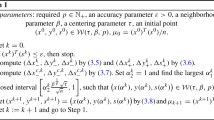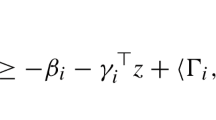Abstract
In this paper we study the homogeneous conic system \(F: Ax = 0, x \in C\setminus \{0\}\) . We choose a point \(\bar s \in {\rm int}C^*\) that serves as a normalizer and consider computational properties of the normalized system \(F_{\bar s} : Ax = 0, \bar s^T x = 1, x \in C\) . We show that the computational complexity of solving F via an interior-point method depends only on the complexity value \(\vartheta\) of the barrier for C and on the symmetry of the origin in the image set \(H_{\bar s} := \{Ax {\bar s}^Tx = 1, x \in C\}\) , where the symmetry of 0 in \(H_{\bar s}\) is
We show that a solution of F can be computed in \(O(\sqrt{\vartheta}{\rm ln}(\vartheta/{\rm sym}(0, H_{\bar s}))\) interior-point iterations. In order to improve the theoretical and practical computation of a solution of F, we next present a general theory for projective re-normalization of the feasible region \(F_{\bar s}\) and the image set \(H_{\bar s}\) and prove the existence of a normalizer \({\bar s}\) such that \({\rm sym}(0,H_{\bar s}) \ge 1/m\) provided that F has an interior solution. We develop a methodology for constructing a normalizer \({\bar s}\) such that \({\rm sym}(0, H_{\bar s}) \ge 1/m\) with high probability, based on sampling on a geometric random walk with associated probabilistic complexity analysis. While such a normalizer is not itself computable in strongly-polynomial-time, the normalizer will yield a conic system that is solvable in \(O(\sqrt{\vartheta}{\rm ln}(m\vartheta))\) iterations, which is strongly-polynomial-time. Finally, we implement this methodology on randomly generated homogeneous linear programming feasibility problems, constructed to be poorly behaved. Our computational results indicate that the projective re-normalization methodology holds the promise to markedly reduce the overall computation time for conic feasibility problems; for instance we observe a 46% decrease in average IPM iterations for 100 randomly generated poorly-behaved problem instances of dimension 1,000 × 5,000.
Similar content being viewed by others
References
Belloni, A., Freund, R.M.: Proejctive pre-conditioners for improving the behavior of a homogeneous conic linear system. Working Paper OR375-05, MIT, Operations Research Center (2005)
Belloni, A., Freund, R.M.: On the symmetry function of a convex set. Math. Program. (2006, to appear)
Bertsimas D. and Vempala S. (2004). Solving convex programs by random walks. J. ACM 51(4): 540–556
Dyer M.E. and Frieze A.M. (1988). On the complexity of computing the volume of a polyhedron. SIAM J. Comput. Arch. 17(5): 967–974
Epelman M. and Freund R.M. (2002). A new condition measure, preconditioners and relations between different measures of conditioning for conic linear systems. SIAM J. Optim. 12(3): 627–655
Fishman G.S. (1994). Choosing sample path length and number of sample paths when starting at steady state. Oper. Res. Lett. 16(4): 209–220
Freund R.M. (1989). Combinatorial analogs of Brouwer’s fixed-point theorem on a bounded polyhedron. J. Comb. Theory Ser. B 47(2): 192–219
Freund R.M. (1991). Projective transformation for interior-point algorithms and a superlinearly convergent algorithm for the w-center problem. Math. Program. 58: 203–222
Geyer C.J. (1992). Practical markov chain monte carlo. Stat. Sci. 7(4): 473–511
Grötschel M., Lovász L. and Schrijver A. (1994). Geometric Algorithms and Combiantorial Optimization. Springer, Berlin
Grünbaum B. (1967). Convex Polytopes. Wiley, New York
Hammer P.C. (1951). The centroid of a convex body. Proc. Am. Math. Soc. 5: 522–525
Kalai A. and Vempala S. (2006). Simulating annealing for convex optimization. Math. Oper. Res. 31(2): 253–266
Kelner, J.A., Spielman, D.A.: A randomized polynomial-time simplex algorithm for linear programming. Technical report. In: Proceedings of the 38th Annual ACM Symposium on Theory of Computing (2006)
Khachiyan L. (1996). Rounding of polytopes in the real number model of computation. Math. Oper. Res. 21(2): 307–320
Leindler L. (1972). On a certain converse of Hölder’s inequality ii. Acta Sci. Math. Szeged 33: 217–223
Lovász, L., Vempala, S.: The geometry of logconcave functions and an O *(n 3) sampling algorithm. Microsoft Technical Report
Lovász, L., Vempala, S.: Hit-and-run is fast and fun. Microsoft Technical Report
Lovász, L., Vempala, S.: Where to start a geometric walk? Microsoft Technical Report
Minkowski H. (1911). Allegemeine lehzätze über konvexe polyeder. Ges. Abh. Leipzog-Berlin 1: 103–121
Nesterov Y. and Nemirovskii A. (1993). Interior-Point Polynomial Algorithms in Convex Programming. Society for Industrial and Applied Mathematics (SIAM), Philadelphia
Nesterov Y. and Nemirovskii A. (2003). Central path and Riemannian distances. Université Catholique de Louvain, Belgium, Technical report, CORE Discussion Paper, CORE
Nesterov Y., Todd M.J. and Ye Y. (1999). Infeasible-start primal-dual methods and infeasibility detectors. Math. Program. 84: 227–267
Prékopa A. (1973). Logarithmic concave measures and functions. Acta Sci. Math. Szeged 34: 335–343
Prékopa A. (1973). On logarithmic concave measures with applications to stochastic programming. Acta Sci. Math. Szeged 32: 301–316
Renegar J. A (2001). Mathematical View of Interior-Point Methods in Convex Optimization. Society for Industrial and Applied Mathematics (SIAM), Philadelphia
Rockafellar R.T. (1970). Convex Analysis. Princeton University Press, Princeton
Tütüncü, R.H., Toh, K.C., Todd, M.J.: SDPT3—a MATLAB software package for semidefinite-quadratic-linear programming, version 3.0. Technical report, Available at http://www.math.nus.edu.sg/~mattohkc/sdpt3.html (2001)
Zhang Y. and Gao L. (2003). On numerical solution of the maximum volume ellipsoid problem. SIAM J. Optim. 14(1): 53–76
Author information
Authors and Affiliations
Corresponding author
Additional information
This research has been partially supported through the MIT-Singapore Alliance.
Rights and permissions
About this article
Cite this article
Belloni, A., Freund, R.M. Projective re-normalization for improving the behavior of a homogeneous conic linear system. Math. Program. 118, 279–299 (2009). https://doi.org/10.1007/s10107-007-0192-7
Received:
Accepted:
Published:
Issue Date:
DOI: https://doi.org/10.1007/s10107-007-0192-7




